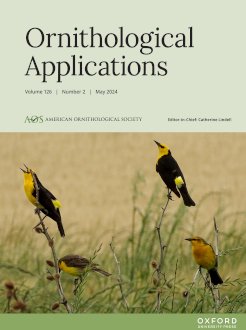Baseline information about declining North American shorebird populations is essential to determine the effects of global warming at low-lying coastal areas of the Arctic and subarctic, where numerous taxa breed, and to assess population recovery throughout their range. We estimated population sizes on the Yukon–Kuskokwim Delta (YKD) in western Alaska on the eastern edge of the Bering Sea. We conducted ground-based surveys during 2015 and 2016 at 589 randomly selected plots from an area of 35,769 km2. We used stratified random sampling in 8 physiographic strata and corrected population estimates using detection ratios derived from double sampling on a subset of plots. We detected 11,110 breeding individuals of 21 taxa. Western Sandpiper (Calidris mauri), Red-necked Phalarope (Phalaropus lobatus), Dunlin (subspecies C. alpina pacifica), and Wilson's Snipe (Gallinago delicata) were the most abundant taxa. We estimated that ∼7 million individual shorebirds were breeding on the entire YKD in 2015 and 2016. Our surveys of this region provided robust population estimates (coefficient of variations ≤ 0.35) for 14 species. Our results indicate that the YKD supports a large proportion of North America's breeding populations of the Pacific Golden-Plover (Pluvialis fulva), the western population of a Whimbrel subspecies (Numenius phaeopus hudsonicus), a Bar-tailed Godwit subspecies (Limosa lapponica baueri), Black Turnstone (Arenaria melanocephala), a Dunlin subspecies (C. alpina pacifica), and Western Sandpiper. Our study highlights the importance of breeding shorebirds of this relatively pristine but climatically sensitive deltaic system. Estuaries and deltaic systems worldwide are rapidly being degraded by anthropogenic activities. Our population estimates can be used to refine prior North American population estimates, determine the effects of global warming, and evaluate conservation success by measuring population change over time.
LAY SUMMARY
Many shorebird populations are declining and estimates of population sizes and trends are essential for effective conservation action.
Limited data indicated previously that the Yukon–Kuskokwim Delta (YKD) had high densities of breeding shorebirds, but the area had never been thoroughly surveyed.
Our results indicate the relatively pristine but climatically sensitive YKD is important to breeding shorebirds in North America, with 21 species and ∼7 million individuals breeding in the region. This area is home to most of North America's breeding Pacific Golden-Plovers, Black Turnstones, Western Sandpipers, and subspecies of Whimbrel, Bar-tailed Godwit, and Dunlin.
Habitat loss and degradation at estuaries and delta ecosystems could be driving population declines for many species.
Our results contribute to refining American shorebird population estimates, determining the effects of global warming, identifying species and sites of conservation concern both on theYKD and elsewhere, and evaluating conservation success by measuring population change over time.
Es esencial la información de base sobre el declive de las poblaciones de aves playeras en América del Norte para determinar los efectos del calentamiento global en las áreas costeras bajas del Ártico y subártico, donde numerosos taxones crían, y para evaluar la recuperación de las poblaciones a lo largo de sus rangos. Estimamos el tamaño de las poblaciones en el Delta de Yukon-Kuskokwim en el oeste de Alaska, en el borde este del Mar de Bering. Realizamos censos terrestres durante 2015 y 2016 en 589 parcelas seleccionadas al azar de un área de 35.769 km2. Utilizamos un muestreo aleatorio estratificado en ocho estratos fisiográficos y corregimos las estimaciones poblacionales utilizando tasas de detección derivadas de un muestreo doble en un subconjunto de parcelas. Detectamos 11.110 individuos reproductores de 21 taxones. Calidris mauri, Phalaropus lobatus, la subespecie C. alpina pacifica y Gallinago delicata fueron los taxones más abundantes. Estimamos que ∼7 millones de aves playeras estaban criando en todo el Delta de Yukon-Kuskokwim en 2015 y 2016. Nuestros censos en esta región proporcionaron estimaciones poblacionales robustas (CV ≤ 0.35) para 14 especies. Nuestros resultados indican que el Delta de Yukon-Kuskokwim alberga una gran proporción de las poblaciones reproductoras de América del Norte de Pluvialis fulva, la población occidental de la subespecie Numenius phaeopus hudsonicus, la subespecie Limosa lapponica baueri, Arenaria melanocephala, la subespecie C. a. pacifica y C. mauri. Nuestro estudio destaca la importancia para las aves playeras reproductoras de este sistema deltaico, relativamente prístino, pero climáticamente sensible. Los estuarios y los sistemas deltaicos en todo el mundo están siendo degradados rápidamente por actividades antropogénicas. Nuestras estimaciones poblacionales pueden utilizarse para refinar las estimaciones poblacionales originales de América del Norte, para determinar los efectos del calentamiento global y para evaluar el éxito de la conservación mediante la medición del cambio poblacional a lo largo del tiempo.






